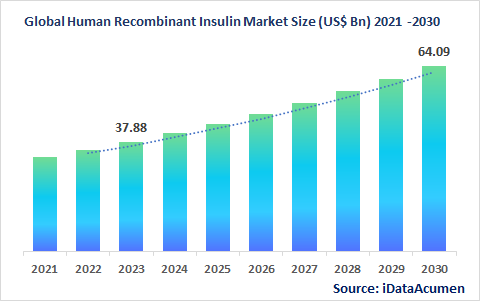Insulin is a natural hormone secreted by pancreas in the body. Insulin acts as a regulator for glucose levels in the body, and helps prevent hyperglycaemia (excessive blood glucose levels). Upon influx of glucose in the blood, pancreas produce insulin which acts as a gateway for the cells to use the glucose as an energy source. In the absence of glucose, cells cannot utilize excessive glucose and it builds up in the blood causing several complications such as hyperglycaemia.
Market Drivers and Restraints:
- Increasing prevalence of diabetes
- According to Centres for Disease Control and Prevention (CDC), in 2019, there were 28.7 million people of all ages had diagnosed with diabetes in the US
- Patients suffering from type 1, and type 2 diabetes are administered with insulin via subcutaneous or intravenous route.
- Type 1 diabetes patients are fully dependant on externally administered insulin as their pancreas are not capable of producing insulin.
- Industry developments such as product launches, acquisitions and collaborations are expected to support market growth over the forecast period. For instance, in 2022, Novo Nordisk launched Tresiba Biologic Analog Insulin to expand affordability options
However, factors such as high costs which reduce treatment access to certain extent and unavailability of cost effective alternatives hinder growth of the market.
Global Human Recombinant Insulin Market is expected to witness a CAGR of 7.8% over the forecast period (2022-2030) to reach US$ 64 Bn by 2030

Competitive Landscape:
The global market for insulin is consolidated with a few multinational corporations dominating in the industry. Key companies operating in the market are well-equipped with large manufacturing facilities and they are engaged in various research and development activities. Some of the prominent players operating in the market are:
- Novo Nordisk A/S,
- Eli Lilly and Company,
- Sanofi S.A.,
- Julphar Gulf Pharmaceutical Industries,
- Biocon Limited, Bioton S.A.,
- Gan & Lee Pharmaceuticals, Ltd.,
- Zhuhai United Laboratories Co., Ltd.,
- Wanbang Biopharmaceuticals Co., Ltd.,
- Dongbao Enterprise Group Co., Ltd.
|
Key Insights |
Description |
|
The market size in 2021 |
USD 35.6 Billion |
|
CAGR (2021 - 2030) |
7.8% |
|
The revenue forecast in 2030 |
USD 64.8 Billion |
|
Base year for estimation |
2021 |
|
Historical data |
2017-2020 |
|
Forecast period |
2022-2030 |
|
Quantitative units |
Revenue in USD Billion, and CAGR from 2021 to 2028 |
|
Market segments |
Product Type, Brand, Distribution Channel, Region |
|
Regional scope |
North America, Europe, Asia Pacific, Latin America, Middle East, and Africa |
|
Market Drivers |
|
|
Market Restraints |
|
|
Competitive Landscape |
Novo Nordisk A/S, Eli Lilly and Company, Sanofi S.A., Julphar Gulf Pharmaceutical Industries, Biocon Limited, Bioton S.A., Gan & Lee Pharmaceuticals, Ltd., Zhuhai United Laboratories Co., Ltd., Wanbang Biopharmaceuticals Co., Ltd., and Dongbao Enterprise Group Co., Ltd. |
Segments Covered in the report:
The global Human Recombinant Insulin Market is segmented based on product type, brand, distribution channel, and region as follows:
- Product Type (Revenue, USD Billion; 2022–2030)
- Rapid-Acting Human Insulin
- Short-Acting Human Insulin
- Intermediate-Acting Human Insulin
- Long-Acting Human Insulin
- Premixed Human Insulin
- Brand Product (Revenue, USD Billion; 2022–2030)
- Humalog
- Novolog
- Apidra
- Humulin R
- Novolin R
- Humulin N
- Novolin N
- Levemir
- Lantus
- Humalog Mix
- Novolog Mix
- Others
- Distribution Channel (Revenue, USD Billion; 2022–2030)
- Hospital Pharmacies
- Retail Pharmacies
- Online Pharmacies
- Region (Revenue, USD Billion; 2022–2030)
- North America
- U.S.
- Canada
- Europe
- Germany
- U.K.
- France
- Italy
- Spain
- Rest of Europe
- Asia Pacific
- China
- Japan
- South Korea
- India
- ASEAN
- Rest of APAC
- Latin America
- Brazil
- Mexico
- Rest of LATAM
- Middle East & Africa
- Saudi Arabia
- UAE
- Rest of MEA
- North America